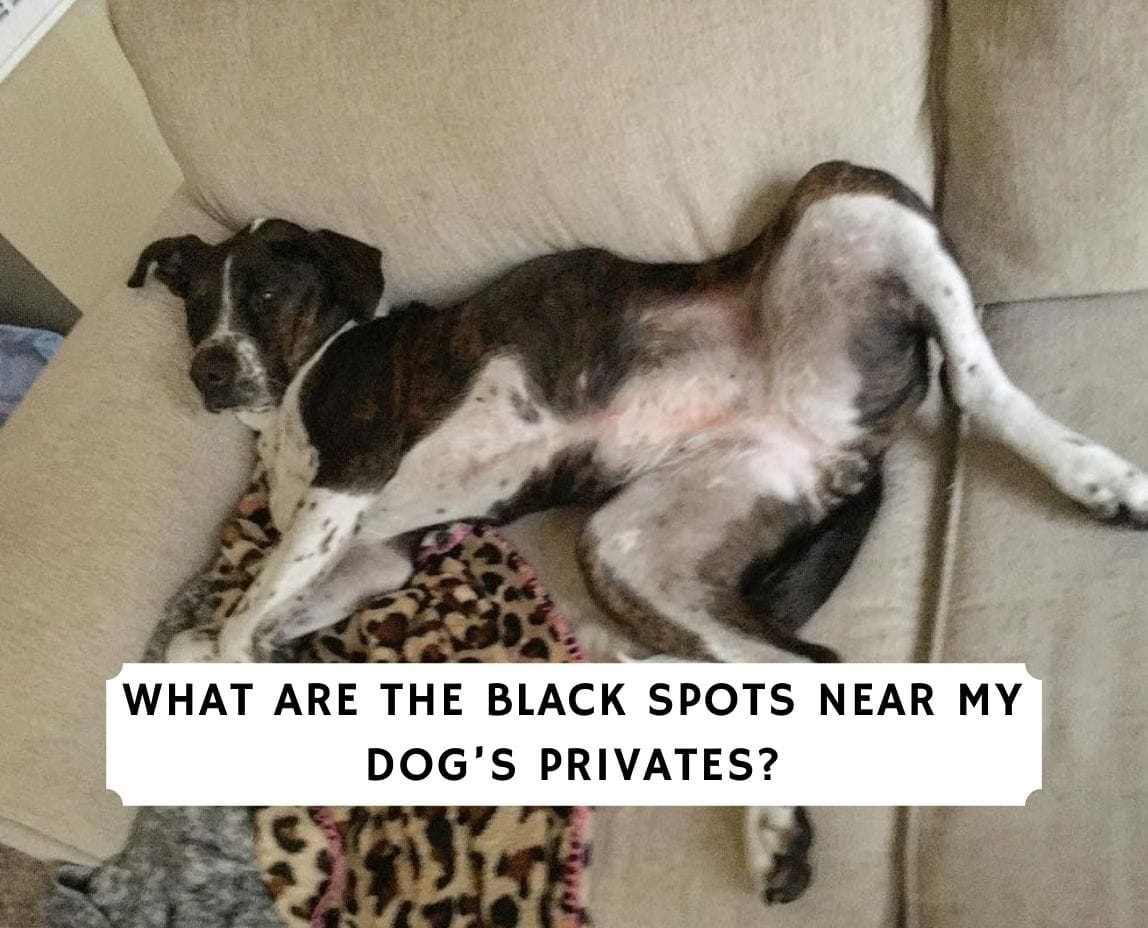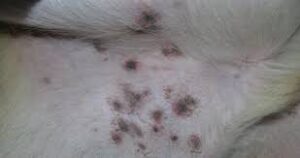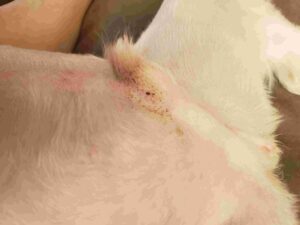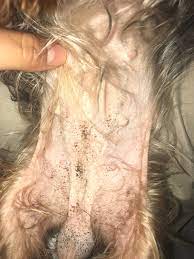Sometimes nothing can be more frightening than finding a new lump, bump, or spot on your dog’s skin. Changes in your dog’s skin can mean a number of things, from nothing to cancer, so it’s always important to have any new changes checked out by a veterinarian.
One of those possibly alarming new changes can be finding black spots near your dog’s privates, belly, or groin area. We’ll help you decide when these spots can be a problem and when you shouldn’t worry about them. Dr. Chyrle Bonk, who is a dog veterinarian, has written this article to give you some of the potential outcomes of why you’re seeing black spots on your dog.
Other articles you would like: Why is my dog so clingy?
What Can Black Spots on a Dog’s Skin Be?
Changes in your dog’s skin color can come with age, sun exposure, and many other causes. Each will have a slightly different presentation and may or may not have any other accompanying symptoms. Below are four common reasons why you might see black spots on your dog’s belly, groan, or near their privates.
Yeast Infection
It’s perfectly normal for dogs to have some amount of yeast on their skin. The numbers are kept in check by a dog’s immune system. If something goes haywire and the yeast is allowed to multiple unchecked, your puppy could show up with a yeast infection. A yeast infection on a dog is an inflammatory skin condition that fairly common in dogs, especially dogs with clumpy skin or excessive skin folds.
Yeast infections on a dog’s skin can be itchy, red, and scaly, or darkly pigmented. They may make the skin appear thick and crusty or flaky as well. Yeast tends to like dark, moist areas, so the groin and genital area are common places to see them, as well as the ear canals. Yeast infections are diagnosed by viewing excessive numbers of yeast under a microscope. A yeast infection will oftentimes appear as black clumps or spots near your dog’s belly or private area.
Related: Best Dog Shampoos for a Yeast Infection
Fleas or Flea Dirt
Occasionally, the dark spots that you see near your dog’s privates can be flea dirt. Flea dirt is the dried blood droppings that are left behind by fleas. Flea dirt will look like black pepper flakes on your dog’s skin. It’s most commonly found at the base of the tail and between the hind legs. They can also show up as black spots near your dog’s privates or groan area.
Flea dirt can be washed off easily from your dog. However, you may also find adult fleas crawling on your dog or they may be scratching excessively. For some dogs that are allergic to fleas, you may also notice little red bumps at the base of the tail, neck, belly, or groin.
Hyperpigmentation
Hyperpigmentation, also known as Acanthosis Nigricans, is a darkening of a dog’s skin. It most commonly occurs in the lightly-haired parts of the body, such as the belly and groin. Hyperpigmentation is either primary or secondary.
-
- Primary: Primary hyperpigmentation is usually a breed-specific issue. There is no other reason behind it. Dachshunds are the most common culprits.
- Secondary: Secondary hyperpigmentation means the skin darkens due to some kind of trauma or irritation. This can be anything from a wound, infection, hormonal imbalance, or underlying disease such as Cushing’s or hypothyroidism. As part of the healing process, the body will use more melanin as sort of a protective layer for the healing skin underneath.
It’s not uncommon for hyperpigmentation to occur at surgery sites, specifically spaying or neutering incisions on the belly or in front of the scrotum. It can also be seen in dogs with skin allergies that cause them to excessively lick or bite their skin, leading to chronic trauma.
Secondary hyperpigmentation may be accompanied by other symptoms, such as redness around the edges, itchiness, swelling, or hair loss and spots on other areas of the body.
Melanomas
Even with a thick hair coat, dogs are not immune to skin cancers such as melanoma. These typically occur where the hair is the thinnest, namely around the genitals, belly, face, and ears due to increased sun exposure. Melanomas will often be raised and irregularly shaped. They may grow and spread quickly. You’ll typically notice darker spots near your dog’s privates.
When Are Black Spots Near My Dog’s Privates a Problem?
Most of the time black spots near your dog’s private parts will be hyperpigmentation and they may not require any treatment. If you have a Dachshund, hyperpigmentation is almost guaranteed and can show up as early as one year of age. Always see your veterinarian if you notice any changes in your dog’s skin and if it is irritating your dog.
If you notice any other symptoms associated with a darkening of the skin, such as itchiness, scaly, flaky skin, or raised bumps that are rapidly changing, it’s time to get some professional advice.
How to Treat Black Spots Near a Dog’s Privates
First, we always recommend that you see your veterinarian to determine the exact cause. For cases of primary hyperpigmentation, the change is often only cosmetic and won’t require any treatment.
For secondary hyperpigmentation, yeast infections, fleas, or melanomas, you have to treat the underlying condition before the skin will lighten up. Fleas can be treated with a topical, oral or spray-on flea medication. Other pets, as well as your house, will need to be treated as well.
Yeast infections will require anti-fungal medications that can be taken orally or applied topically. Antibiotics may also be needed to prevent or treat secondary bacterial infections as well. Some yeast infections may require several weeks of treatment.
Melanomas will need surgical removal, depending on where they are located on your dog. Chemotherapy or radiation is often recommended as a follow-up.
Whatever the underlying cause of the black spots near your dog’s privates may be, it’s going to take some time for that skin to get back to normal. Even once the inciting cause is cleared, it will still take a while for that pigmented skin to turn over into lighter colored skin.
Conclusion for What Are the Black Spots Near My Dog’s Privates?
Finding dark spots near your dog’s privates, or anywhere on their skin, can be alarming. Be sure to consult your veterinarian anytime you find any changes with your dog’s skin or hair coat to ensure that you’re getting the best treatment as soon as possible. Most of the time, a black spot on your dog’s belly or near their privates is due to a yeast infection, flea dirt, hyperpigmentation, or melanomas.
Other articles you would like:

Dr. Sabrina Kong graduated from the Royal Veterinary College in England in 2016 and has been working at a small animal clinic in Northern California since then. She grew up in the Bay Area and got her bachelor’s degree from Cal Poly San Luis Obispo. She also became a Certified Canine Rehabilitation Practitioner through a program at the University of Tennessee.
When she isn’t in the clinic taking care of her four-legged patients, she enjoys traveling and trying new foods with her friends and her three-legged dog, Apollo. She adopted Apollo from her clinic when he was a puppy with numerous health issues. Dr. Kong truly cares about taking care of animals.



